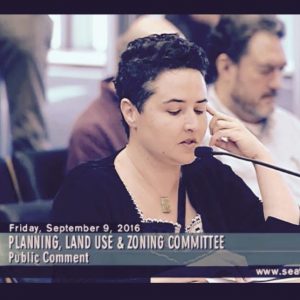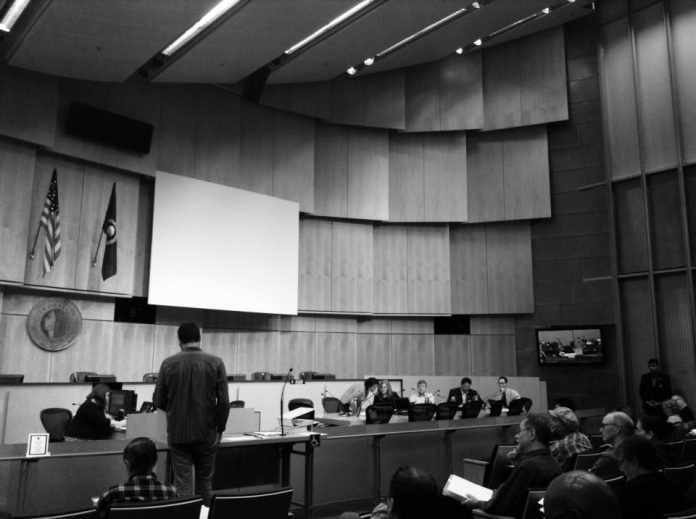(….and why do all these urbanists talk in this funny shorthand that makes me feel stupid…)
The abundance of acronyms in land use discussions frequently leaves newcomers feeling left out and overwhelmed. Many urbanists seem particularly caught up in using shorthands, like FAR, TOD, MHA, ROW, and MIZ. Are they showing off? Are they in a hurry to try to convince you of something? Is it an essential part of every nerd subculture? One year later, I hear myself doing the same thing I hated a year ago.
When I started attending various meetings and happy hours surrounded by Seattle urbanists, I was often one of the only women in the room. People were eager to share their knowledge with me and their passion about land use, but these discussions also felt a lot like mansplaining. The next time you are attending The Urbanist monthly meetup or city land use meeting, I encourage you to ask the person you are speaking with to define each and every acronym. We need to remind building professionals, city employees, and housing nerds that their technical language is not common knowledge. At The Urbanist, every article that uses an acronym, we always spell out what the acronym means in case it’s your first time seeing the term.
As a former Housing Affordability and Livability Agenda (HALA) focus group member and former representative at the Northeast District Council, I have observed people intimidated to speak up because of the jargon. It is imperative that the city fund “Land Use 101” education like the Roosevelt Neighborhood Association. I suspect that much of the mistrust of city officials is a lack of shared language to discuss land use decisions. When planning professionals–often nervously and defensively standing in front of a concerned crowd–use a secret code, it hurts the transparency of the process. We need more plain human everyday speech to demystify land use terms. (Another gigantic barrier to understanding housing policy is the complex math equations that vary depending on land use discussions over public, private, commercial, single-family residential, or multi-family residential. Again, education is needed but we could all work harder to make the language simpler.)
One acronym that is thrown around amongst neighbors who are urbanists is “PLUZ”. Hey, you should attend the next PLUZ meeting! Wow, did you see the amendments introduced at that last PLUZ meeting?

What is “PLUZ”?
The City of Seattle’s Planning, Land Use, and Zoning Committee is tasked with providing “policy direction and oversight and to deliberate and make recommendations on legislative matters relating to: planning and land use, including comprehensive planning, zoning, design, and land use regulations as well as incentive zoning, the Affordable Housing Impact Mitigation Program, and equitable transit oriented development; major institutions; quasi-judicial decisions; and community development.” The PLUZ Committee is chaired by Councilmember Rob Johnson (District 4) along with Councilmembers Mike O’Brien (District 6) and Lisa Herbold (District 1).
The next meeting of the PLUZ Committee–which is a deeply important one–will be on January 19th at 2pm where Councilmembers will discuss the next steps for the University District rezone. I encourage you to listen or watch online at the Seattle Channel, even if you cannot attend in person. Local land use discussions are nuanced and wonky. Daytime meetings seem to favor attendees who are retired or who attend on behalf of an organization. It is important that the city host more evening meetings. November’s very well attended evening meeting on the U District rezone, the latest in over a hundred public meetings on that issue, spurred pro– and anti-rezone petitions, intense back-and-forths on NextDoor and competing yard signs, some even homemade.
The PLUZ Committee meets in the City Council Chambers. It is typically scheduled to meet at 9.30am on the first and third Tuesday every month, which will likely include upcoming meetings on February 7th, February 24th, March 7th, and March 21th. You can stay up-to-date on the meetings by signing up online for future agendas.
And in case you’re still curious about the acronyms from the first paragraph:
FAR: floor area ratio. The portion of the zoning code that largely determines density by stipulating a maximum ratio a building’s floor area can be in relation to the size of piece of land on which it’s built .
TOD: transit oriented development. Typically refers to larger development projects near light rail stations or bus stops, often more focused on pedestrian accessibility and with fewer parking stalls than auto-oriented development.
MIZ: mandatory inclusionary zoning. Zoning that requires a percentage of new units are set aside for low income people, usually in exchange for off-sets like density bonuses.
MHA: Mandatory Housing Affordability. The City of Seattle’s particular branding of mandatory inclusionary zoning, which would go live with passage of the requisite zoning changes (upzones).
ROW: right of way. The government-owned space that hosts our streets, including not just the roadway, but bike lanes, sidewalks, landscaping, and buffers.

Laura Loe
Laura Loe is an educator, musician, and gardener from Colombia/NY/LA/Chicago who has lived in Seattle since 2009. Laura is a board member for Be:Seattle, an organization building the power and leadership of renters and people experiencing homelessness to fight displacement.


